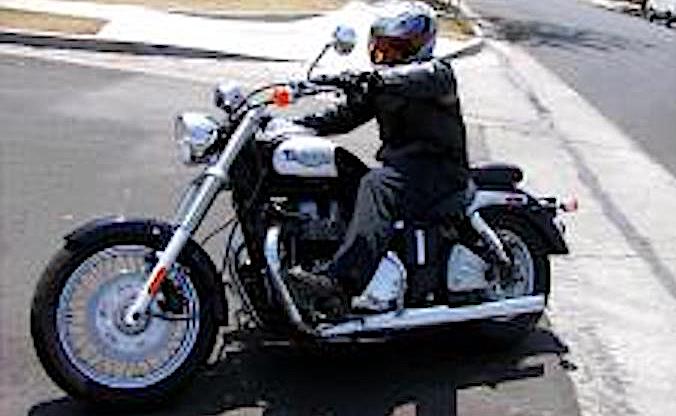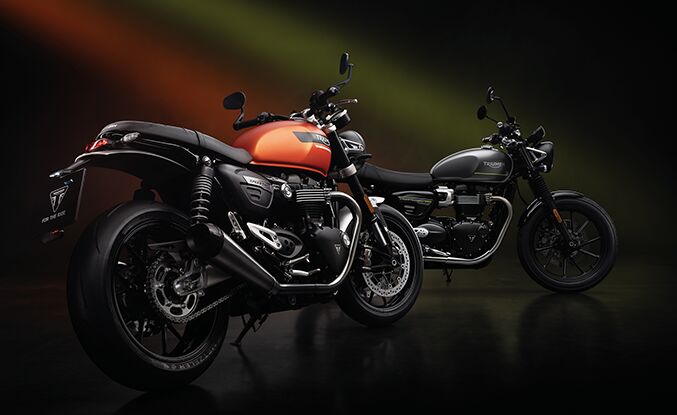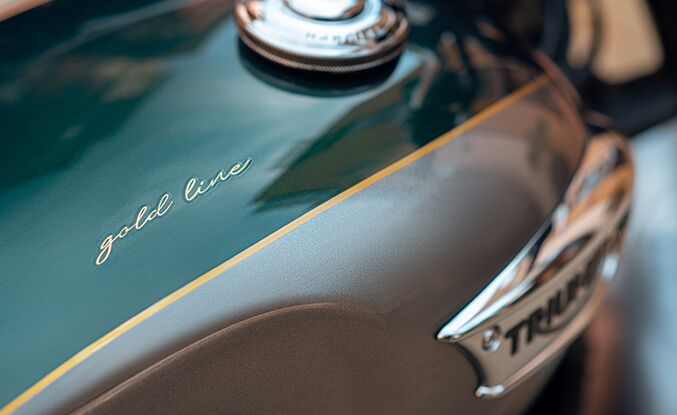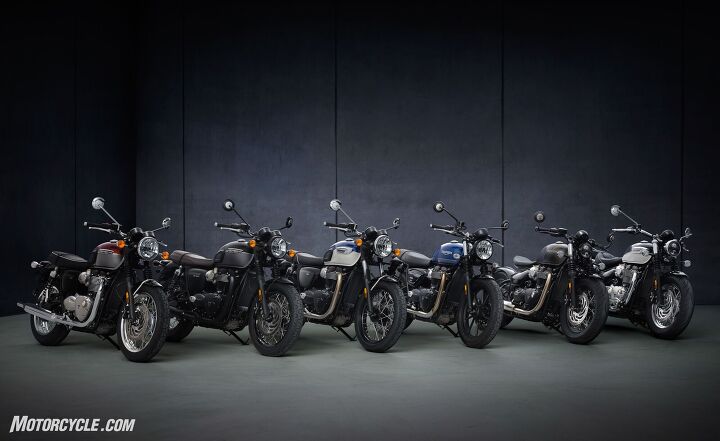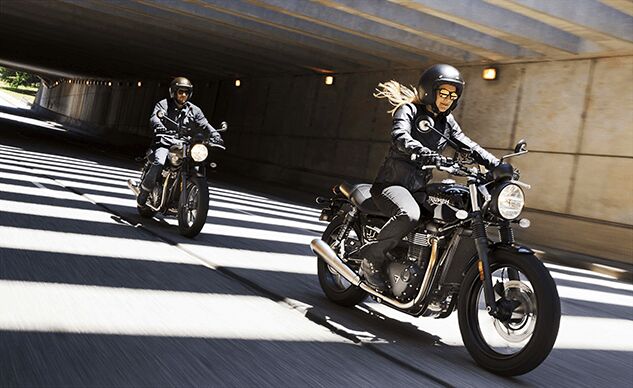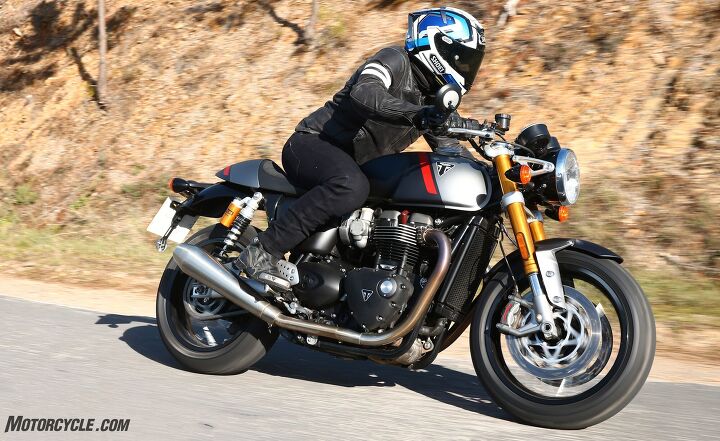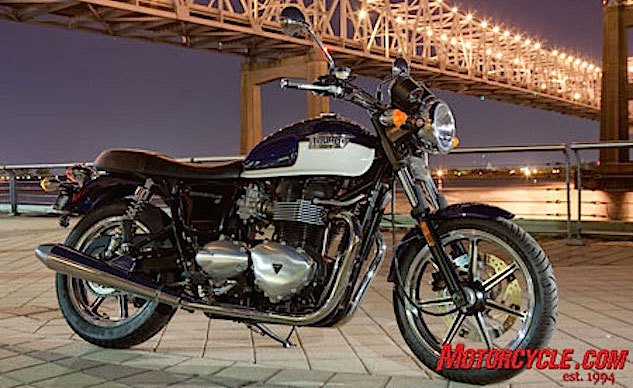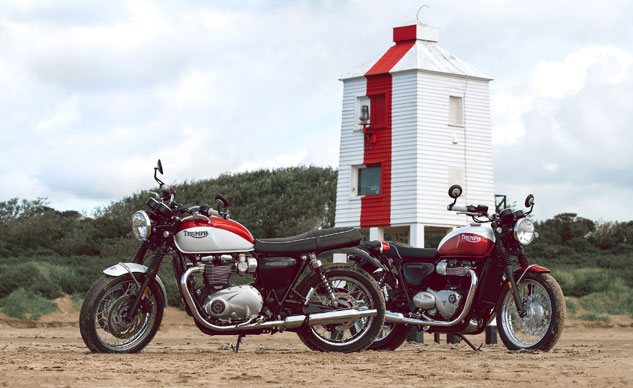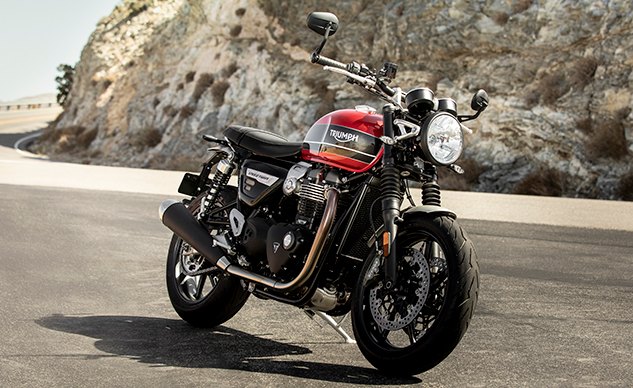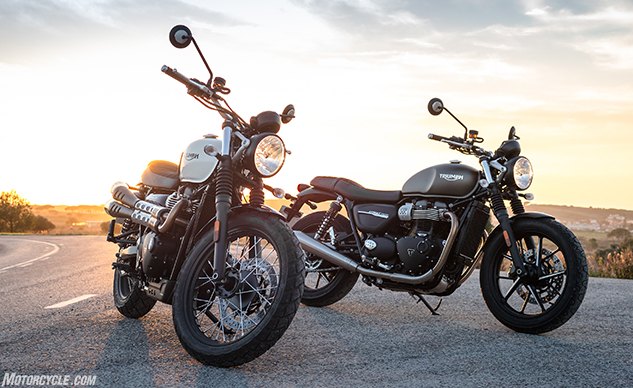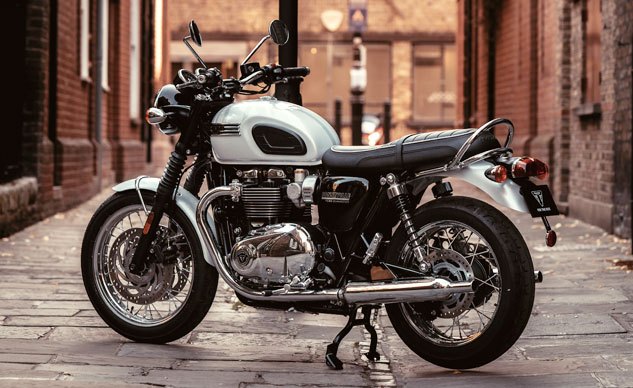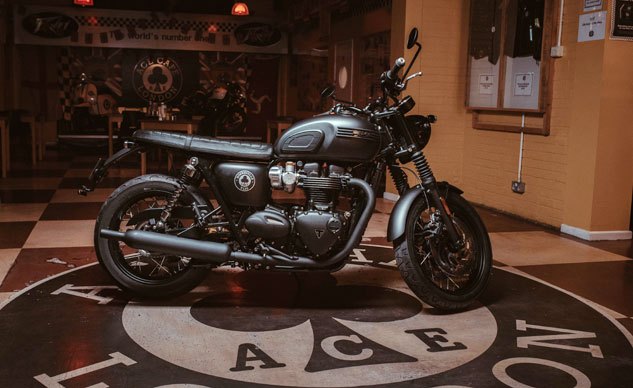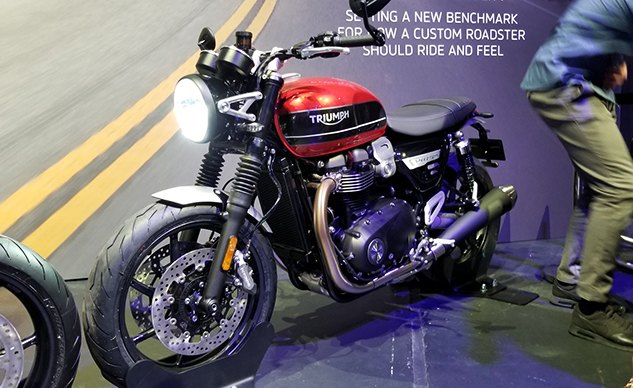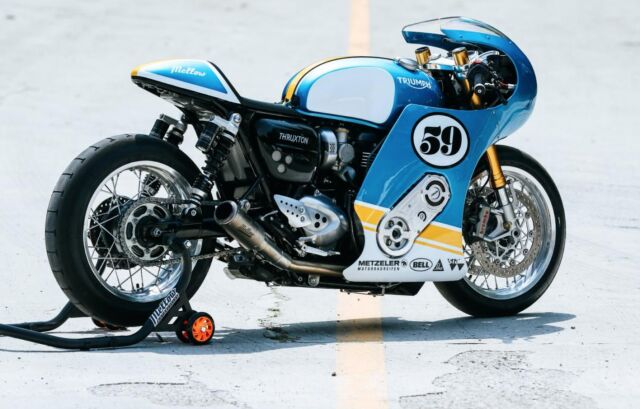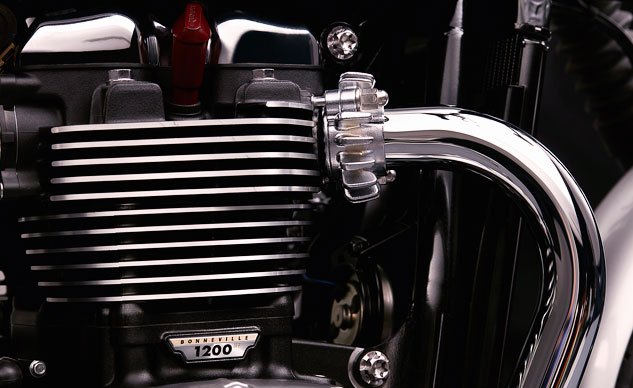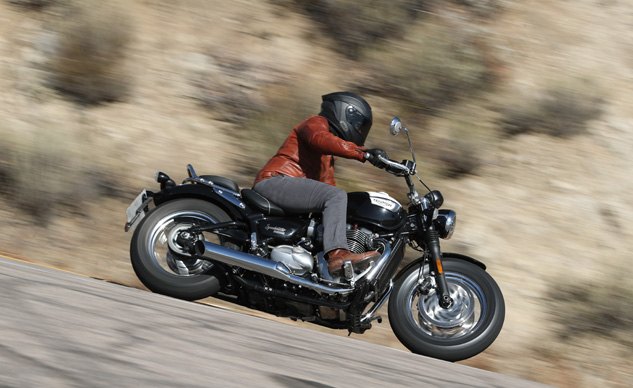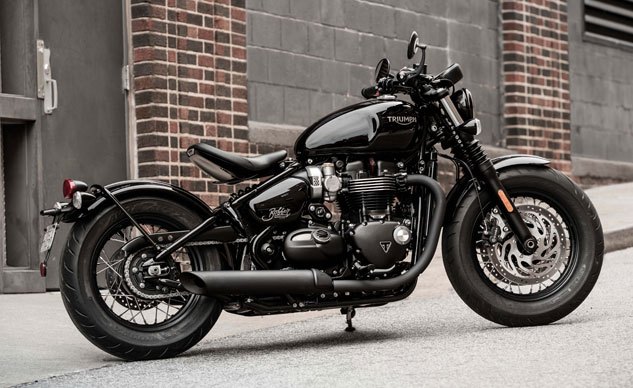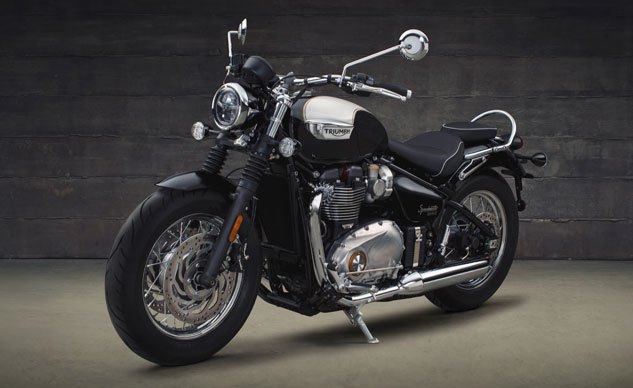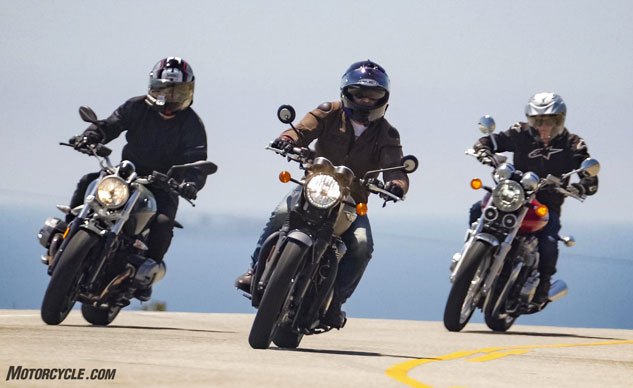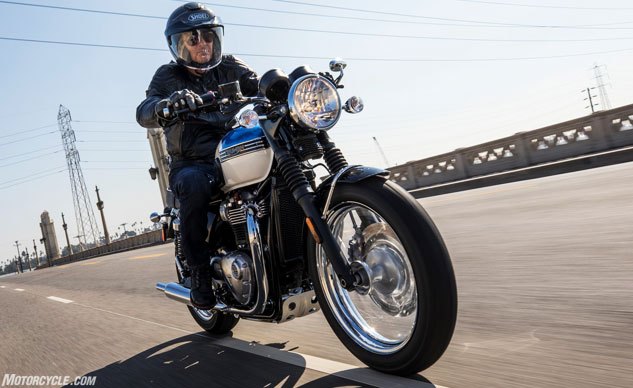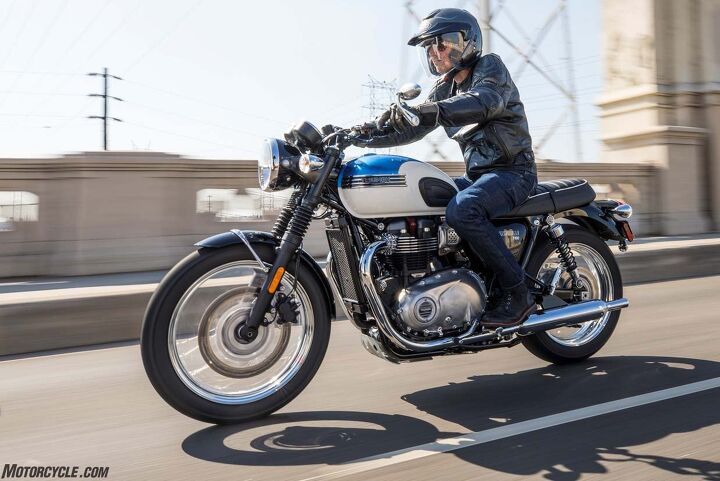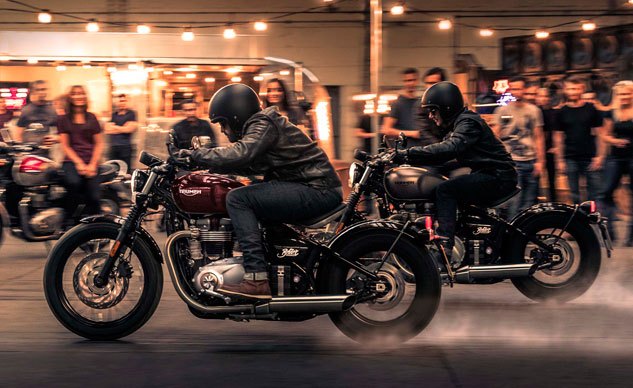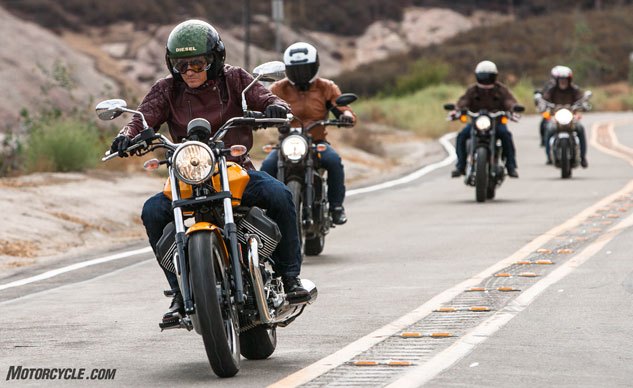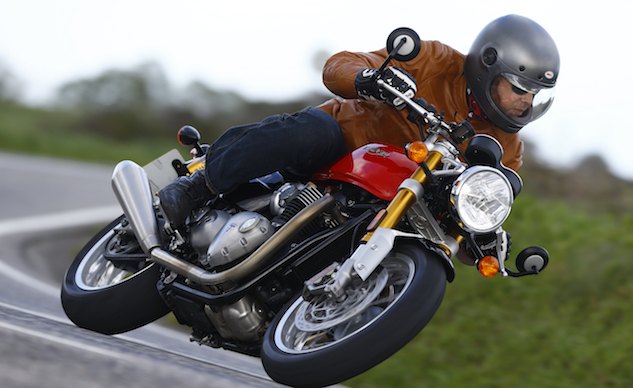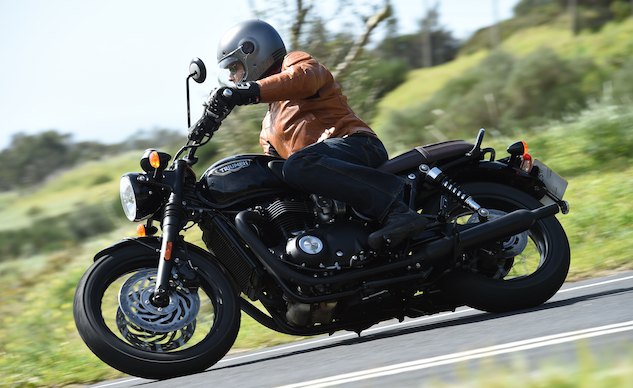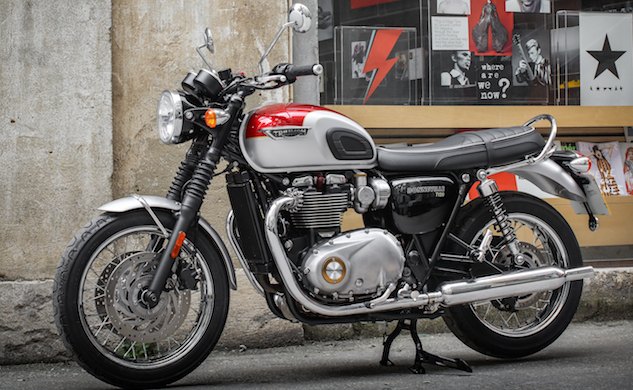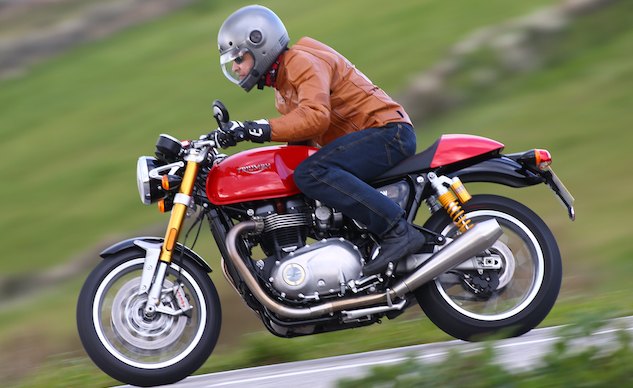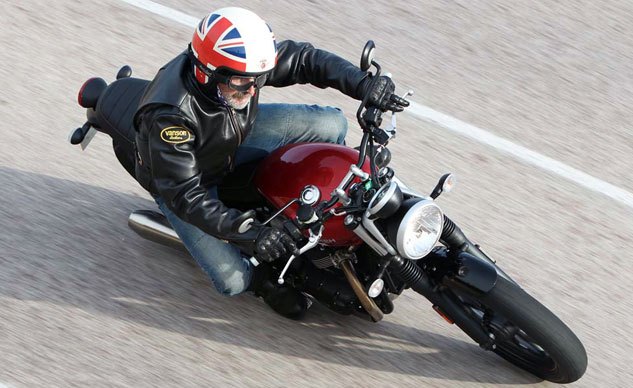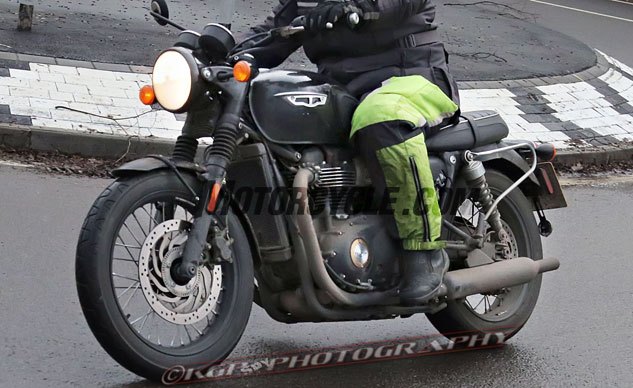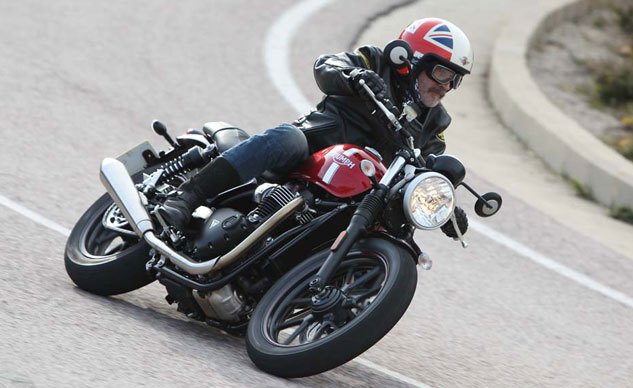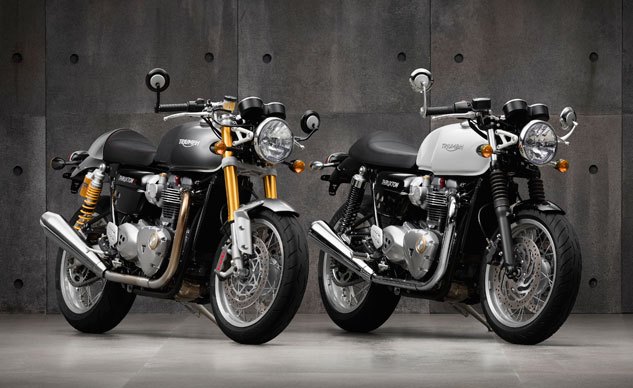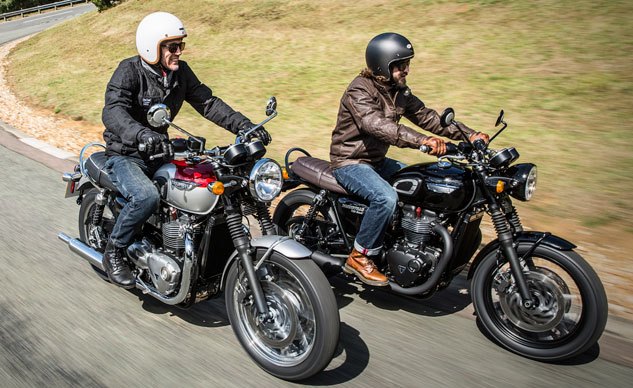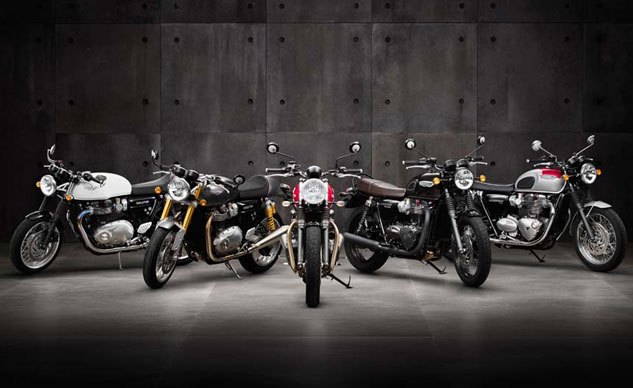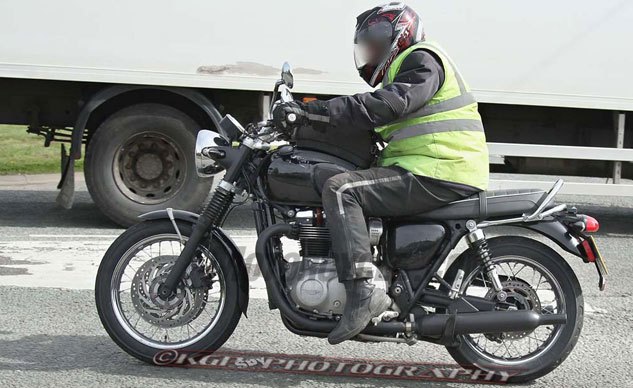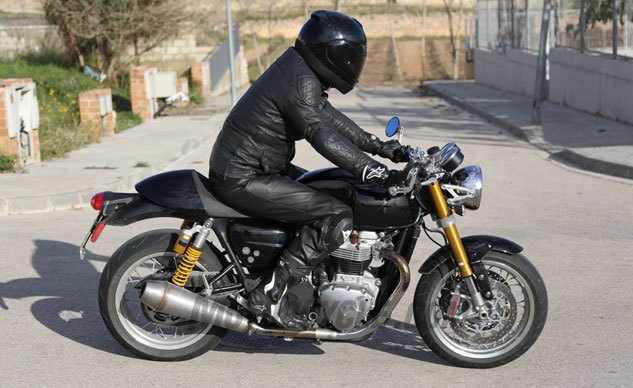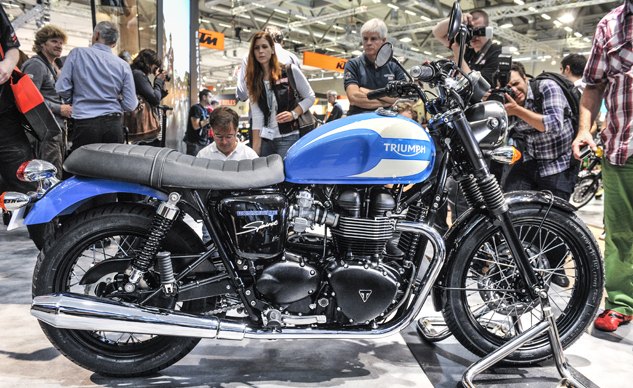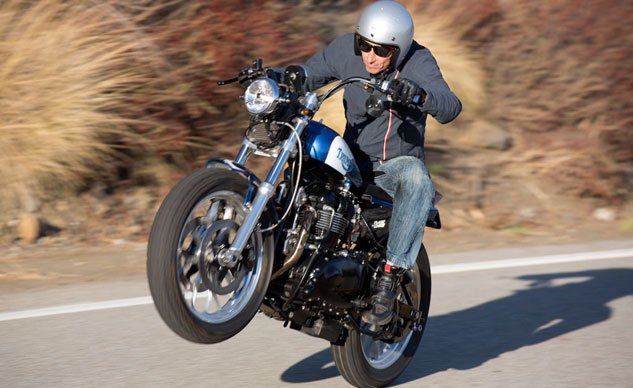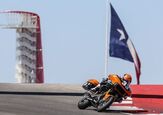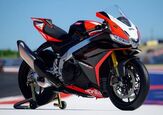Triumph Triumph Bonneville
Triumph Unveils The 10-Bike Chrome Collection
Nobody does modern classics quite like Triumph, and today, the famed British marque is taking full advantage of its position within the modern classic space by unveiling its new, 10-bike strong limited edition Chrome collection of motorcycles. How limited? Each bike will only be available for one year.
Church of MO: 2002 Triumph Bonneville America
Today a Motorcycle.com photo shoot is at least a half-day affair involving thousands of dollars worth of Canon’s finest gear and millions of pixels. Twenty years ago, it was a 10-minute errand on the way to lunch at the FlatCat on Normandie, with Clavin’s clapped-out Olympus and half a roll of film. And let’s not forget to stock up on Sparks on the way back to the office. I had completely forgotten about the Triumph Bonneville America, but it feels like we liked it.
2023 Triumph Modern Classics Range Get New Colors, New Names
Triumph announced updated color options for its Bonneville “Modern Classics” range, as well as new names for the Street Scrambler and Street Twin.
Special Edition 2022 Triumph Bonneville Gold Line Models Announced
Following the introduction of the limited edition Street Twin Gold Line model, Triumph announced it is giving the rest of its modern classics the same treatment. Unlike the Street Twin, of which only 1,000 units were produced and promptly sold, the new Gold Line Edition models will be produced only for the 2022 model year and will not be limited to a specific number.
2021 Triumph Bonneville Family Receives Update
Triumph Bonneville is one of those iconic motorcycles that even non-riders know the name of, perhaps because their father rode one back in the day. In recent years, the Bonneville has grown into a decent-sized family, and like all families, the Bonnevilles change over time. Today, the 2021 Triumph Bonneville family made their first public appearance, and apparently, they have been taking pretty good care of themselves during the pandemic. While Euro 5 compliance leads the list of changes each Bonnie model underwent, the good folks at Hinckley took the opportunity to grace a handful of key changes on each Bonneville model.
Triumph Modern Classics Certified as 2022 Models
Following the reveal of the 2021 Triumph Speed Triple RS last week, we couldn’t help but notice that Triumph’s 2021 model lineup looked a little sparse. We’ve now entered the second month of the year, and Triumph still has yet to announce the Bonneville or any of its “Modern Classics” for the 2021 model year.
2020 Triumph Thruxton RS Review – First Ride
The Thruxton namesake is one that has described Triumph’s racing efforts throughout the middle of the past century. Now, the name designates a model that harkens back to those days that’s thoroughly modern while being meticulously designed to look the part of cafe racers from the 1960s. This new Thruxton RS continues to refine and develop Triumph’s factory cafe racer into a machine that will properly haul the mail and look smashing while doing so.
Church of MO: 2009 Triumph Bonneville
Ten years ago the Bonneville turned 50. Should Triumph get to celebrate these milestones, even though it’s the reincarnation of the deceased original? The answer is of course it should: Resurrecting a dead thing from the ashes is the sincerest form of corporate loyalty. Such a quaint concept. Render unto Bloor what is Bloor’s.
2020 Triumph Bud Ekins Bonneville T120 and T100 Special Editions
Stop us if you’ve heard the story about ’60s hearthrob Steve McQueen and his friendship with Hollywood Triumph dealer/racer Bud Ekins, who went on to be a great stunt rider/driver in a slew of McQueen moving pictures. Stop us even if you haven’t heard it, because it’s in Triumph’s press release below. These cool Bonnevilles are Bud’s payback.
2019 Triumph Speed Twin First Look
The legendary Speed Twin is back, returning as the newest member of Triumph‘s 1200cc Bonneville lineup. The new 2019 Triumph Speed Twin slots into the line by combining the Thruxton‘s performance with the Bonneville T120‘s more comfortable riding position.
2019 Triumph Street Twin / Street Scrambler Review – First Ride
The main difference between the 2016 Street Twin and 2017 Street Scrambler, and the new 2019 versions of each, is that my Aerostich Roadcrafter suit is much snugger when riding the new ones. On the first day we rode the new bikes from Cascais, Portugal, down the road to Lisbon in the rain. Semi-lost and wandering along, I was all set to conclude I couldn’t tell much difference between new and old. On Day Two, the rain had stopped, the roads were drying, and our Official Triumph Guide became a Brit called Nick Plumb, former Paris-Dakar regular.
2019 Triumph Bonneville T120 Diamond Edition First Look
In addition to a special Ace Cafe-themed edition Bonneville, Triumph announced a limited production Diamond Edition to commemorate the 60th anniversary of the original Bonneville T120.
2019 Triumph Bonneville T120 Ace First Look
Triumph introduced two one-off limited edition models at EICMA, one recognizing the 60th anniversary of the Bonneville and the other paying tribute to the legendary Ace Cafe in London. You can read more about the Bonneville T120 Diamond separately, but here is the 2019 Triumph Bonneville T120 Ace.
2019 Triumph Speed Twin and Scrambler 1200 Leak From Dealer Meeting
Triumph held its global dealer conference today, and, because it’s the 2018, photos from the presentation have leaked out on social media. Pictured above is the new 2019 Triumph Speed Twin and below, the 2019 Triumph Scrambler 1200.
Mellow Motorcycles' Triumph Phantom Blaze
Triumph, along with so many other motorcycle manufacturers with their wits about them, is all about the customization. As an example of what’s possible, they rolled out “Phantom Blaze” along with their updated models at Intermot a couple weeks ago. At first, I thought it was a new model. Yes, that’s what the world needs! A supercharged Thruxton!
2019 Triumph Street Twin and Street Scrambler Updates Coming to Intermot
We already know Triumph is introducing a new 1200cc Scrambler, and the California Air Resources Board has certified a new Speed Twin, and now it looks like the British manufacturer will also be updating its 900cc Street Scrambler and Street Twin for 2019.
CARB Certifies 2019 Triumph Speed Twin
The California Air Resources Board has issued an executive order certifying the 2019 Triumph Bonneville 1200 engine, revealing an as-yet-unannounced brand new Speed Twin model for 2019.
2018 Triumph Bonneville Speedmaster First Ride Review
The Bonneville family continues to expand with its 2018 Triumph Bonneville Speedmaster. The new Speedmaster builds on the Bobber and Bonneville lines to offer a versatile cruiser with a level of refinement and finish that has become synonymous with Triumph’s recent model releases.
2018 Triumph Bonneville Bobber Black Revealed
The fastest-selling Triumph ever produced is going dark, as Triumph introduces the new Bonneville Bobber Black. The 2018 Triumph Bonneville Bobber Black is more than just a new color option, as Triumph has added a fat front wheel, dual disc brakes, thicker forks and a number of other upgrades.
2018 Triumph Bonneville Speedmaster Revealed
Triumph revealed its new Speedmaster, a modern British cruiser that shares many similarities with the Bonneville Bobber but with more practical versatility. The 2018 Triumph Bonneville Speedmaster is targeted for those who like the Bonneville T120 but want more touring capability and cruiser styling or a Bonneville Bobber but want seating for a passenger.
Retro Roadsters Revisited: BMW R NineT Pure Vs Honda CB1100EX Vs Triumph Bonneville T120 Black
When last we visited this class three years ago, it wasn’t exactly this class but it was close. Triumph’s new Bonnevilles hadn’t been born yet, so a Moto Guzzi Griso 8V completed the threesome, along with the then-new Honda CB1100 and the original BMW R nineT.
2017 Triumph Bonneville Bobber Video Review
You’ve read the Review, now see the video! Heart-stopping wheelies, lurid smoldering burnouts and an awesome display of moto-skill. Okay, well, none of that, sadly, but there is some nice action footage of Triumph’s latest, greatest all-new Bonneville variant through the rolling countryside outside Madrid, Espana. And, about two minutes of me channeling Walter Cronkite as I lay out the new bike’s salient points in living color.
2017 Triumph Bonneville T100 Video Review
Triumph’s new generation of Bonneville models gets expanded to four with the introduction of the T100 Bonneville, and we were one of the first publications on the planet to take it for a spin.
2017 Triumph Bonneville T100 First Ride Review
Triumph’s new Bonneville platform has already made a significant impact on the moto market in less than a year. Spearheaded by the 900cc Street Twin and followed closely by the 1200cc T120 Bonneville and Thruxton models, the retro-modern roadsters are selling as quickly as Triumph can build them, with strong sales forcing the company to add an extra shift at its factory to meet demand.
2017 Triumph Bonneville Bobber Preview
Introduced earlier today at a live event in England, the new Triumph Bonneville Bobber made its way to the stage ridden by none other than SBK racing legend, Carl Fogarty. Based on the all-new Bonneville released earlier this year, the Bobber receives a few notable items, namely a faux hardtail rear suspension setup, an adjustable solo saddle, and twin slash-cut mufflers.
Heritage Lifestyle Characters Compete On Cool Factor
Maybe it’s human nature, but motorcycle publications are constantly trying to determine which bike can lap the fastest, jump the highest, or travel the farthest. Competition is what feeds the beast. Motorcycle.com’s as guilty of it as anyone, and it’s easy to see why: motorcycling has become so segmented these days, with machines designed to satisfy one particular niche. They do it very well, too; sportbikes are insanely advanced, adventure bikes are capable of traversing nearly any terrain, and both cruisers and sport-tourers can pound out miles in two very different, yet also very satisfying, ways. And we haven’t even mentioned streetfighters, nakeds, and standards…
2016 Triumph Thruxton R Video Review
For 2016, Triumph launched two new Thruxton models, the base model Thruxton ($12,500) and the Thruxton R ($14,500). Both are huge improvements over the outgoing model Thruxton. The new 1200cc liquid-cooled parallel-Twin produces gobs more horsepower and torque, the chassis isn’t the flexi-flyer it used to be, and modern electronics (R-b-W, ride modes, TC, ABS) bring a touch of modernity to a motorcycle steeped in nostalgia. For a complete review of the bike and its performance check out our previously published 2016 Triumph Bonneville Thruxton R First Ride Review.
2016 Triumph Bonneville T120 Video Review
For 2016, the ground-up new Triumph Bonneville comes in two visually disparate color options: the T120 and T120 Black. There are no performance differences between the two unless you consider back-in-black badassness to be a performance advantage. Both models begin with a base model price of $11,500, rising in $250 increments according to paint options.
2016 Triumph Bonneville T120 First Ride Review
The cover came off and sunlight struck the red and silver paint of the late sixties Bonneville for the first time in a quarter century. Only 1,300 miles after purchasing it, the original owner gave his life in Vietnam, and the bike has since sat in the corner of his mother’s garage. I should have bought it then and there, but didn’t. The memory haunts me still, like an old girlfriend I should have married but never asked. Nineteen years later I’m standing in front of a 2016 Bonneville T120 wondering if I’ll make the same mistake twice.
2016 Triumph Bonneville Thruxton R First Ride Review
Having low expectations exceeded is always preferable to high expectations not being met. With all the hype surrounding Triumph’s Bonneville Thruxton reboot, I attended the press launch under the premise of the Thruxton being a stylized Bonneville racer lacking the performance for which it’s namesake implies. How surprised was I to discover that a traction-control system was the only thing keeping the fuel tank from smacking me in the chest when grabbing a fistful of throttle for the first time.
Triumph Street Twin Dyno Results
At both the unveiling and riding introduction of Triumph’s new Street Twin, the manufacturer noted that the new 900cc engine made more torque – and at lower rpm – than the previous 865cc mill. At the riding introduction, Triumph expanded its claim to include the Street Twin producing less peak horsepower than the previous, smaller engine. So, imagine our surprise when we actually get our sweaty mitts on a production model Street Twin and dash it over to our local dyno shop – and learn that the new engine makes both more torque and horsepower than the most recent dyno run we have of the old 865cc engine.
SPIED! 2017 Triumph Bonneville 900
It’s sunny and 65 here today in SoCal, but that doesn’t stop us lusting after the new 900cc Triumph Bonneville, spotted testing near Triumph HQ in Hinckley in the UK on what doesn’t look like a very pleasant day.
2016 Triumph Street Twin First Ride Review
Wow, this is sort of dangerous ground Triumph is treading with its new Hi-Torque-engined Street Twin: Its all-new bigger, more modern, liquid-cooled 900cc parallel-Twin actually makes, ahhhh, less peak horsepower than the previous generation 865cc unit. That’s why they insisted we journalists ride the bike before the tech presentation, and kept the cocktails flowing the night before. Savvy marketing on their part. Triumph claims just 54 horsepower (at 5900 rpm) for the new motor, which is at least 10 hp less than I’d have estimated from my butt-clench dyno after a day’s spin around Valencia and environs on the new bike.
2016 Triumph Thruxton and Thruxton R
Carrying the banner of the Bonneville’s racing heritage, Triumph looked to the Thruxton, appropriately taken from the 500-mile racing series that first helped garner the Bonnie’s racing cred. While, as with all the new Bonnevilles, the authentic appearance is important, the primary emphasis with the 2016 Triumph Thruxton and the R was on power and handling.
2016 Triumph Bonneville T120 and T120 Black
UPDATE: Triumph has announced U.S. pricing for its 2016 Bonneville lineup. The Bonneville T120 and T120 Black are available in Jet Black for $11,500. The Cinder Red Bonneville T120 is priced at $11,750 while the two-tone Cranberry Red/Aluminum Silver and Jet Black/Pure White options will be sold for $12,000. The Bonneville T120 Black will also be available in matte Graphite for $11,750.
Triumph Announces Three New Engine Configurations and Five All-New Models for 2016 Bonneville Line
Suppose you ran a motorcycle manufacturer lucky enough to have produced one of the most iconic motorcycle lines of an era. For the past 15 years your factories had assembled a popular family of motorcycles based on that previous generation to steady increase in sales, ultimately totaling 20% of the company’s international purchases. Still, progress marches onward, global emissions laws change, and the time is ripe for refreshing and broadening the model line. Having stewardship over an icon carries a special weight, making any revision fraught with risk. However, where there is risk, often there is great opportunity nearby. Triumph Motorcycles found itself in just that position with the Bonneville and set about the task of updating and broadening the family to meet today’s motorcycling while remaining true to its heritage.
2016 Triumph Bonneville: Spy Shots
Fresh spy photos of what’s purported to be an all-new liquid-cooled Triumph Bonneville for 2016 have just surfaced from across the pond. They reveal a new engine, new chassis and new styling that’s even more authentically retro than the current model.
New Triumph Bonneville Spied!
In December we published spy photos of a Triumph “Street Tracker” prototype, which boasted a new liquid-cooled parallel-Twin engine that we theorized would form the basis of Triumph’s lineup of classically styled motorcycles.
Triumph Street Tracker and Street Tracker R Spied!
Motorcycle.com has acquired these spy images of two new Triumph prototypes undergoing testing in Spain, and they reveal a new liquid-cooled powerplant that will surely underpin all future Bonnevilles, Thruxtons, Scramblers, etc.
Intermot 2014: 2015 Triumph Bonnevilles
Today at Intermot, Triumph unveiled not one, but three new Bonneville variants: the Bonneville Spirit, Bonneville T214, and the Bonneville Newchurch.
2013 Bonneville Performance Street Tracker Review
If you believe modern motorcycles are too mild-mannered and polite, you’ll be interested in reading about Bonneville Performance’s wild and wooly Street Tracker. It’s a grin factory and a heart attack on two wheels, boasting mega power and a stripped-down lightweight chassis, a package not far removed from the legendary vintage Triumph dirt-trackers ridden by Gene Romero and the dearly departed Gary Nixon.




